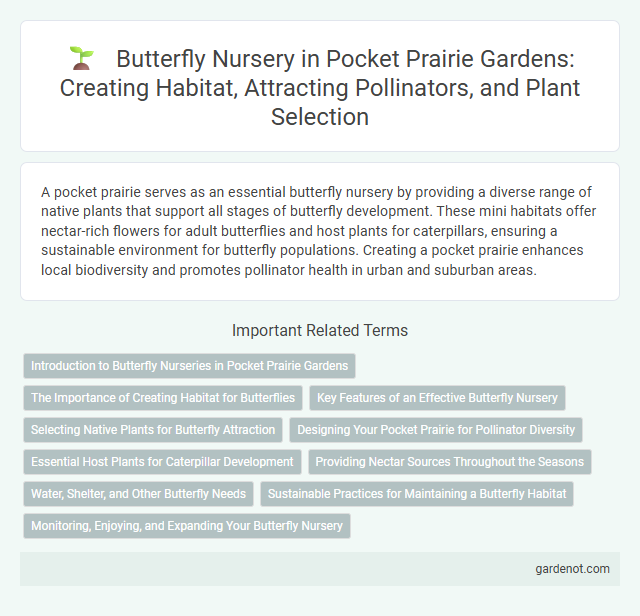A pocket prairie serves as an essential butterfly nursery by providing a diverse range of native plants that support all stages of butterfly development. These mini habitats offer nectar-rich flowers for adult butterflies and host plants for caterpillars, ensuring a sustainable environment for butterfly populations. Creating a pocket prairie enhances local biodiversity and promotes pollinator health in urban and suburban areas.
Introduction to Butterfly Nurseries in Pocket Prairie Gardens
Butterfly nurseries in pocket prairie gardens provide essential habitat for pollinators by cultivating native host plants and nectar sources. These specialized gardens support butterfly lifecycles, from egg to adult, enhancing biodiversity and ecosystem health. Incorporating a variety of milkweed, coneflower, and goldenrod species encourages greater butterfly visitation and successful reproduction.
The Importance of Creating Habitat for Butterflies
Creating habitat for butterflies in a pocket prairie supports biodiversity by providing essential resources like nectar plants, host plants for caterpillars, and shelter from predators. These habitats enhance pollination, which benefits nearby crops and wild plants, contributing to ecosystem health and resilience. Establishing butterfly nurseries in urban and rural areas helps reverse decline in butterfly populations caused by habitat loss and pesticide use.
Key Features of an Effective Butterfly Nursery
An effective butterfly nursery features a diverse selection of native nectar plants and host plants essential for caterpillar development, ensuring species-specific habitat support. It incorporates sheltered areas to protect from predators and harsh weather, alongside shallow water sources to aid in hydration. Proper spacing and sunlight availability optimize butterfly attraction and breeding success within the nursery.
Selecting Native Plants for Butterfly Attraction
Selecting native plants for a butterfly nursery in a pocket prairie enhances local biodiversity by providing essential nectar sources and larval host plants. Species such as milkweed (Asclepias spp.), coneflowers (Echinacea), and goldenrod (Solidago) offer critical habitats and food for native butterfly species like monarchs and swallowtails. Incorporating a diverse array of native flowering plants ensures continuous blooming periods, supporting butterfly populations throughout their life cycles.
Designing Your Pocket Prairie for Pollinator Diversity
Designing your pocket prairie to maximize pollinator diversity involves planting a variety of native flowering plants that bloom at different times throughout the growing season, providing continuous nectar and pollen sources for butterflies. Incorporate host plants like milkweed and violets, essential for butterfly larvae, alongside nectar-rich wildflowers such as coneflowers and goldenrod to support multiple butterfly species. Structuring your pocket prairie with layered vegetation, including grasses and flowering herbs, creates habitats that enhance butterfly survival and promote a resilient pollinator ecosystem.
Essential Host Plants for Caterpillar Development
Essential host plants for caterpillar development in a pocket prairie butterfly nursery include milkweed, goldenrod, and violet species, which provide crucial food sources for larvae. These native plants support monarch, swallowtail, and fritillary caterpillars by supplying necessary nutrients for growth and metamorphosis. Incorporating a diverse array of host plants enhances butterfly biodiversity and promotes healthy population cycles.
Providing Nectar Sources Throughout the Seasons
A Pocket Prairie butterfly nursery offers a variety of native flowering plants that bloom sequentially from early spring to late fall, ensuring a continuous supply of nectar for butterflies. Species such as milkweed, goldenrod, and coneflowers are strategically planted to support different butterfly species at various life stages. This seasonal nectar availability boosts butterfly populations and promotes biodiversity in urban and rural environments.
Water, Shelter, and Other Butterfly Needs
A thriving butterfly nursery in a pocket prairie requires consistent access to fresh water sources like shallow puddles or damp sand to support hydration and nutrient intake. Providing diverse shelter options such as native grasses, wildflowers, and shrubs creates protective microhabitats essential for resting and breeding. Incorporating nectar-rich plants and host species ensures butterflies have the necessary food and habitat to complete their life cycles successfully.
Sustainable Practices for Maintaining a Butterfly Habitat
Sustainable practices for maintaining a butterfly habitat in a pocket prairie include planting native milkweed and nectar-rich wildflowers that support local butterfly species throughout their life cycles. Avoiding pesticides and herbicides preserves beneficial insects and promotes biodiversity, enhancing ecosystem health. Proper site management, such as controlled burns or selective mowing, encourages plant diversity and provides butterflies with essential shelter and breeding grounds.
Monitoring, Enjoying, and Expanding Your Butterfly Nursery
Regular monitoring of your pocket prairie butterfly nursery ensures optimal plant health and early detection of pests or diseases, promoting a thriving habitat for native butterfly species such as monarchs and swallowtails. Enjoying your nursery involves observing pollination behaviors and lifecycle stages, enhancing both educational and ecological value in your backyard. Expanding your butterfly nursery by incorporating diverse native nectar and host plants increases butterfly biodiversity and strengthens local ecosystems.
Butterfly nursery Infographic

 gardenot.com
gardenot.com